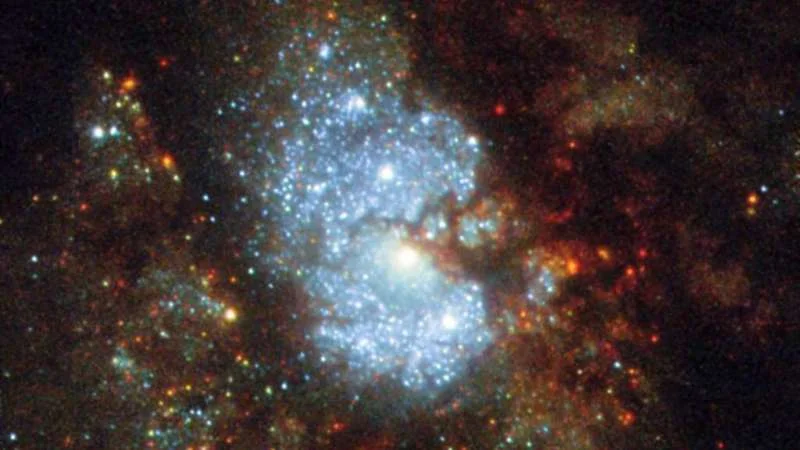Astrophysicists study primordial gases to study how galaxies were born
- June 27, 2023
- 0
Studying the universe isn’t easy, and not just because of the great distances. If you want to study the galactic fodder where stars and galaxies form, you usually
Studying the universe isn’t easy, and not just because of the great distances. If you want to study the galactic fodder where stars and galaxies form, you usually

Studying the universe isn’t easy, and not just because of the great distances. If you want to study the galactic fodder where stars and galaxies form, you usually have to look at parts of the universe where there is no visible light due to the aforementioned absence of stars. Astrophysicists compensate for this with spectroscopy, which allows them to not only “see” wavelengths of light invisible to the naked eye, but also detect energy in the range from radio waves to gamma waves. So they can analyze the content of very distant cosmic phenomena.
In a recent study Nature State of North Carolina astrophysicist Rongmon Bordoloy was part of a team that discovered “primitive gases” located far from galaxies. By detecting and studying the composition of these gases, the team hopes to unravel at the most fundamental level the mystery of how galaxies are born and what they are made of.
Bordoloy: We discovered two primordial gas clusters hundreds of thousands of light-years from neighboring galaxies. These “clusters” are clouds of neutral atomic gas that are fairly compact in size relative to the galaxy; They are about 10 times smaller than a normal galaxy.
We identified them using the Atacama Large Millimeter Array (ALMA), a large array of radio telescopes located in the Atacama Desert in Chile. We discovered the forbidden transition of a single ionized carbon atom that creates a specific spectral signature. This signature means that the signal comes from an extremely dense gas cloud.
This spectral signature, combined with the absence of “visible” stars when we observed the same region with the Hubble Space Telescope, meant that a primitive gas cloud/galaxy existed in that region.
Bordoloy: That’s a good question. How these clouds form is still a mystery. These clouds are detected by detecting the forbidden radiation of carbon in infrared light, as I described above. However, they do not emit any optical or ultraviolet light (which we can detect), indicating that there are no stars in these clouds.
One hypothesis is that these dense clouds formed when gas from the intergalactic medium (the vast cosmic web in which most of the baryons in the early universe was located) cooled. Or, conversely, they may have formed from dense clouds of gas excited by strong radiation from galaxies.
Bordoloy: Yes, they play a role in the formation of galaxies. Gravity means that these clouds will eventually fall on the galaxies and form stars, thus increasing the mass of the galaxies. In fact, it is one of the main channels (gas falling into galaxies) through which galaxies grow from relatively small galaxies in the early universe to a large galaxy like the Milky Way today.
Bordoloi: These primordial gas clouds are found near many other galaxies, and the space between them is filled with the hot (100,000 Kelvin degrees) plasma we’ve discovered. This discovery shows that there was a significant mixture of chemical gases in the early universe. For example, supernovae that exploded in early galaxies could eject a lot of ionized plasma from these galaxies, which would eventually fall back into the galaxies and form the next generation of stars. So the first universe is indeed a dynamic environment; It is a kind of space machine that processes rich gas, and this “machine” eventually creates the complex atoms and molecules that abound in our solar system today.
Bordoloy: The discovery of these primordial dense gas clouds was completely unexpected and made us seriously wonder how such primordial gas clouds could exist. Note that this project is only possible because we can combine observations from space (Hubble Space Telescope images), ground-based spectroscopy, and ground-based submillimeter depth observations (from ALMA).
The ability to perform such multi-wavelength searches is one of the unique aspects of this project, which has yielded truly unexpected and exciting scientific results. This synergy of bringing together all sources and wavelength ranges to perform a coherent scientific experiment is, in my opinion, a truly wonderful aspect of this work. Source
Source: Port Altele
As an experienced journalist and author, Mary has been reporting on the latest news and trends for over 5 years. With a passion for uncovering the stories behind the headlines, Mary has earned a reputation as a trusted voice in the world of journalism. Her writing style is insightful, engaging and thought-provoking, as she takes a deep dive into the most pressing issues of our time.